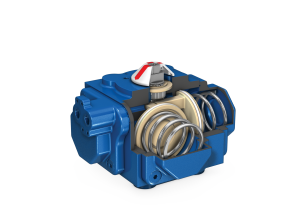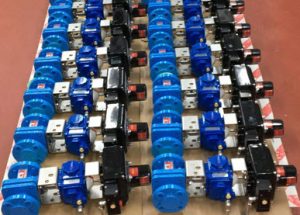MENUMENU
Discover our range of actuators, including rotary, pneumatic, and linear options, designed to meet diverse motion control needs across industries.
Linear actuators generate linear motion to operate valves and are available in numerous styles. They are commonly used with valves such as Globe, Gate, and Diaphragm Valves, delivering reliable performance and precise control. Discover all our linear actuators.

Rotary actuators produce rotational motion to operate rotary valves such as Ball Valves, Plug Valves, and Butterfly Valves. These actuators come in a wide range of styles, ensuring compatibility with different valve configurations and applications. Discover all our rotary actuators.
Manual valve actuators encompass a variety of options, including:

ESI Technologies Group specialises in supplying valve actuators and actuated valves that meet clients’ unique specifications. We offer specially engineered solutions for a wide range of applications, ensuring optimal performance and reliability. As an official distributor for Habonim Compact Actuators, we provide products backed by a remarkable 7-year warranty.
Our comprehensive services extend to the assembly of actuation valves and assemblies, customised to your specific process requirements. With a dedicated full-service department, we possess the expertise and resources to deliver high-quality solutions that enhance your operations. We provide a wide range of actuators, including linear actuators , rotary actuators, and pneumatic actuators, to suit various industrial applications
For pneumatic actuation of rotary valves such as ball, butterfly, and plug valves, the two primary types of actuators are:
For linear pneumatic actuators used with gate and globe valves, the air is employed to facilitate the upward and downward movement of the rising stem. Common types of linear actuators include diaphragm and cylinder styles, offering efficient and precise linear control.
In actuation, fail-safe refers to the mechanism that activates when the air supply to a single-acting actuator is lost or the power supply to the solenoid fails. In such situations, the valve automatically moves to a safe position (fail-safe) using the force of the springs. This safe position can be either open or closed, depending on the desired outcome that ensures safety and optimal operation.
For more information on valve actuators and actuated valves, we invite you to contact ESI Technologies Group. Our team of experts is available to discuss your specific requirements, offering customised solutions tailored to your needs.
To get in touch, please call us in Ireland at +353 21 4510900 or in the UK at +44 1633 877505. Alternatively, you can reach us through our online form or web chat.
ESI Technologies Group is committed to delivering reliable, high-performance valve actuation solutions that optimise control, enhance efficiency, and ensure operational excellence.